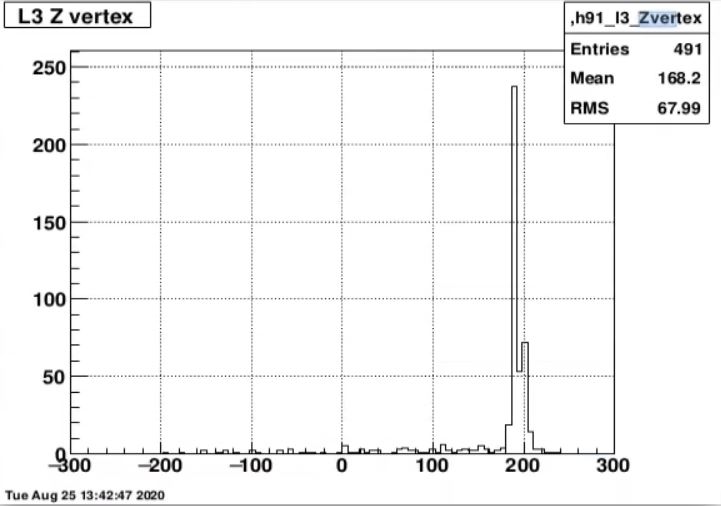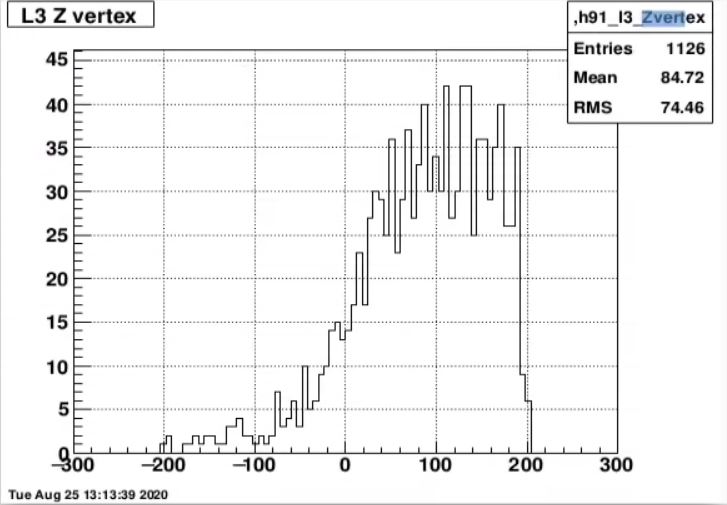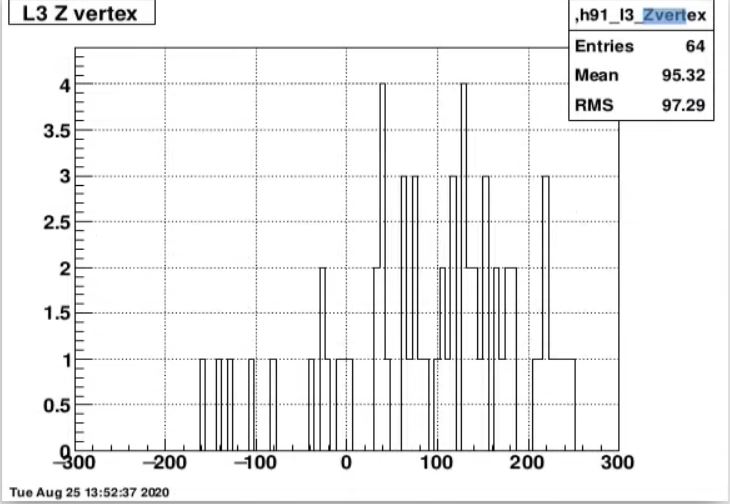Yellow Stream (ZB) Vertex in 26.2GeV AuAu
There have been some concerns that offline doesn't see vertexes in the yellow stream data, despite seeing normal behavior in the physics stream, and seeing vertexes in the zerobias data.
I checked this using run 21226030, and using the old L3 tracking (as used in the online plots), I would make exactly the same conclusion (regarding the yellow stream) if I treated this niaively, but after sorting for triggers, of course, we see that the vertexes are as expected.
Even so, the number of vertexes in BOTH the yellow stream AND the zerobias stream are significantly different than a straight calculation would give. Moreover, the niaive expection for the number of events in the yellow stream that would contain a vertex should be 10 times larger than that in the zerobias stream because the yellowBeamSync trigger is restricted to filled bunches while the zerobias trigger is not. During the fixed target runs there were only 12 filled bunches out of 120. Furthermore, the backgrounds during the fixed target running were very small, so we don't expect to see a large number of tracks coming from anything other than valid collisions.
In regards to the question of good events within the yellow stream, there are exactly 537 events in the yellow stream that were also triggered as good hlt events. These events (from the yellow stream) give the following distribution of vertexes:
Note that within the quality of the l3 tracking, these are about what is expected for all events hitting the target. Also, the number of events with vertexes is > 90%, again consistent with good events being handled by the rough tracking...
If we make exactly the same plot for all yellowBeamSync triggers we get results exactly the same as in Dmitry's results. (This plot is drawn from 20k yellow vertex events):
However, in this sample of events there are only about 36 hltgood events. That is we only expect vertexes from about 36 events! This plot is actually consistent with exactly that. The number of vertexes near the target is in the mid 30's. The problem is that the long tail between 50cm and 200cm is not sensible! We do not have any significant sources of background in this region. Note however, that 5.6% of the yellow stream events have a vertex. This is ~20-30 times higher than the expected rate of 1500hz / (9e6/10)=.16%.
The same behavior occurs in the zerobias data:
This plot is drawn from all 1170 zerobias events triggered in this run. There are 64 events with vertexes, a 5.4% ratio However, the expected number of vertexes should be 10 times smaller than that of the yellow sync trigger. (The ratio should be about 1500hz / 1e9 = .016%. However, ignoring the smaller statistics, the distribution of vertexes is exactly the same as the distribution for the yellowBeamSync trigger (which is expected, even though the exact distribution is not).
The fact that the beam sync doesn't matter between the two triggers, however, is a big clue. I think that the vertexes in the region between 50-200cm are coming from out of time events. Obviously these only come from one side of the TPC at a time, but early events would should up in this region for the west TPC, wheras late events would show up in the same region for tracks in the east TPC. Assuming that about 1/2 of the TPC is necessary to get valid tracks, the ration of about 200 extra eligible candidates for the zero bias trigger and 20 extra eligible candidates for the yellow sync trigger demonstrate why the two triggers should the same number of reconstructed vertexes.
Finally, I don't know how to interpret the observation that we see events in the zerobias stream that come from the vertex. There less than a handfull of such events in all of the runs we have taken to date. The HLT-good overlap with the zerobias stream is exactly 2 events to date. It's possible that Gene's method (which looks at tracks themselves rather than looking at vertexes) strongly enhances target collisions, and whatever background collissions do exist. It's also possible that there is a seed or something in the tracking that takes such tracks and directs them preferentially towards the target. But I still don't understand that observation.
- jml's blog
- Login or register to post comments



